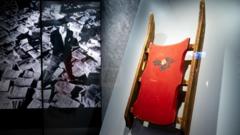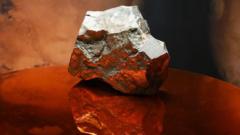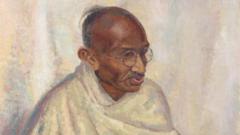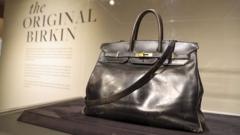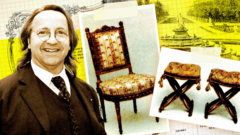The auction holds historical significance as it is tied to a scandal that marred Marie Antoinette's reputation.
Marie Antoinette's Diamond Necklace Fetches $4.8 Million at Auction
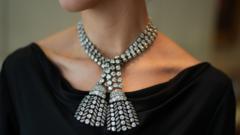
Marie Antoinette's Diamond Necklace Fetches $4.8 Million at Auction
Jewelry linked to the former French queen sells for nearly double its estimated price.
The diamond necklace believed to be connected to a notorious scandal involving Marie Antoinette has sold for an impressive $4.81 million (£3.8 million) at a recent auction in Geneva. This exceptional Georgian piece, adorned with approximately 500 diamonds, grossed nearly double Sotheby's initial estimate, surprising many in attendance. Jewelry expert Andres White Correal from Sotheby's remarked on the electric atmosphere of the evening and noted the overwhelming joy of the unnamed female buyer, who expressed her delight, stating, "I'm exceptionally happy that I won this lot; but I don't own it, I’m merely the custodian until the next person will come along."
The sale took place on Wednesday, generating excitement and interest around the historical significance of the necklace, which may include diamonds from the infamous "affair of the diamond necklace" scandal of the 1780s. This incident greatly impacted Marie Antoinette's image, eventually contributing to her downfall. The scandal was orchestrated by Jeanne de la Motte, a woman of noble descent who, out of desperation, impersonated the queen to deceive a cardinal into handing over the necklace without any payment, which tarnished Marie Antoinette’s reputation despite her innocence in the matter.
Marie Antoinette was born in Austria in 1755 and became the child bride of Louis XVI of France. Her reign was cut short when she was executed during the French Revolution in 1793 at the age of 37. The necklace sold at auction bears evidence of having original jewels that were once part of a grand assembly of jewels which, over time, had been sold and scattered through black-market dealings. Notably, a jeweler on London’s Bond Street acquired over half of the original necklace's diamonds for £10,000 shortly after their controversial exit.
Some experts assert that the age and quality of the diamonds in the necklace sold recently align well with the original jewels. The necklace has a rich history, as it was previously donned by the Marquess of Anglesey during Queen Elizabeth II's coronation in 1953, as well as during King George VI's crowning in 1937. It remained within the Anglesey family collection for almost a century before being sold to a private collector in Asia in the 1960s.
The sale took place on Wednesday, generating excitement and interest around the historical significance of the necklace, which may include diamonds from the infamous "affair of the diamond necklace" scandal of the 1780s. This incident greatly impacted Marie Antoinette's image, eventually contributing to her downfall. The scandal was orchestrated by Jeanne de la Motte, a woman of noble descent who, out of desperation, impersonated the queen to deceive a cardinal into handing over the necklace without any payment, which tarnished Marie Antoinette’s reputation despite her innocence in the matter.
Marie Antoinette was born in Austria in 1755 and became the child bride of Louis XVI of France. Her reign was cut short when she was executed during the French Revolution in 1793 at the age of 37. The necklace sold at auction bears evidence of having original jewels that were once part of a grand assembly of jewels which, over time, had been sold and scattered through black-market dealings. Notably, a jeweler on London’s Bond Street acquired over half of the original necklace's diamonds for £10,000 shortly after their controversial exit.
Some experts assert that the age and quality of the diamonds in the necklace sold recently align well with the original jewels. The necklace has a rich history, as it was previously donned by the Marquess of Anglesey during Queen Elizabeth II's coronation in 1953, as well as during King George VI's crowning in 1937. It remained within the Anglesey family collection for almost a century before being sold to a private collector in Asia in the 1960s.

